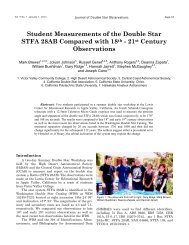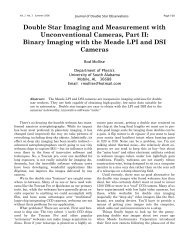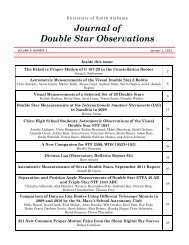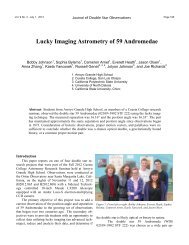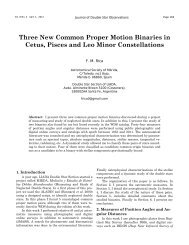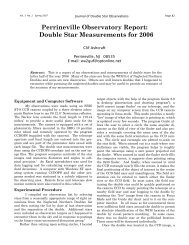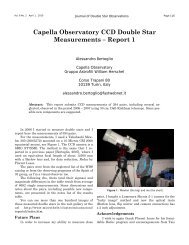Double Star Measurements for 2009 - JDSO.org
Double Star Measurements for 2009 - JDSO.org
Double Star Measurements for 2009 - JDSO.org
You also want an ePaper? Increase the reach of your titles
YUMPU automatically turns print PDFs into web optimized ePapers that Google loves.
Vol. 6 No. 4 October 1, 2010Journal of <strong>Double</strong> <strong>Star</strong> ObservationsPage 293<strong>Double</strong> <strong>Star</strong> <strong>Measurements</strong> <strong>for</strong> <strong>2009</strong>Frank Smith20 Coburn WayJaffrey, NH 03452fhasmith@myfairpoint.netAbstract: I report the measurement of 19 WDS binary systems in <strong>2009</strong>. The observations were conductedwith the AREO2 robotic telescope located at the GRAS Observatory, Mayhill, NM, USA . Discussionincludes remarks on several John Herschel “neglected” doubles. In<strong>for</strong>mation about instrumentationand methodology and results is included.Introduction and InstrumentationI have been imaging “neglected' double stars <strong>for</strong>several years using the equipment at Global Rent-a-Scope (http://www.global-rent-a-scope.com/). Thesemeasures are my first reported results using thisfacility.The program of measuring the visual doublesused the AREO2 telescope at the GRAS Observatory.The instrument is a Takahashi Mewlon 300 Dall-Kirkham Cassegrainian reflector. The telescope isf9.1 with an approximate focal length of 2730mm.The imaging camera is ST8E NAB CCD with 9 micronpixels. Field of view is 11.5 x 17.3 arcminutesand the resolution is approximately 0.6 arcseconds/pixel. The OTA is mounted on a Bisque Paramount1100 German equatorial mount of excellent pointingaccuracy.The mount is capable of quickly and accuratelyslewing to a selected double star. The system takesabout one minute to take an exposure and save theresulting image in a FITS <strong>for</strong>mat. To maximize telescopetime, the FITS images are stored on the RASserver and are retrieved later to be analyzed by suitablesoftware. The relatively short focal length of thissystem restricts measurements of doubles to pairs >5 arcseconds in most cases.MethodsImaging was conducted by entering the coordinatesof the double into the robotic telescope’s webinterface. A test exposure was taken and checked <strong>for</strong>centering and proper exposure. If all was well, anexposure run of 5 to 7 images through a clear filterwas run <strong>for</strong> each pair. Exposures typically ran about10-12 seconds <strong>for</strong> 10-13 magnitude doubles.Each image in the exposure sequence was examinedand any trailed or sub-par images were discarded.MOP Canopus was used to reduce the images(Warner 2006). Any image that the software couldnot reach a plate solution was also discarded.Canopus produces an astronomic solution to the imagebased on the UCAC3 catalog ( Zacharias et al.2010) The software measures double stars using asubroutine built into Canopus. It also produces agreat amount of in<strong>for</strong>mation about the astrometricsolution. All images were copied to archival CD-ROMmaterial and are available by request from the author.The starting and ending images were blinked—just in case.ResultsTable 1 shows the results <strong>for</strong> the 16 doublesmeasured.DiscussionHJ1536This John Hershel double was observed once in1828 and had a measured PA of 113 and a SEP of6.00 arcseconds. The reported magnitudes were11.60 and 12.60. I imaged the starfield centered onthe reported position of HJ1536 on <strong>2009</strong>.524. TheCCD image reveals 11.71 magnitude single star 3U-CAC 234-240864 right at Herschel's position of20:33:43 +26:58:52.6, but no double. In addition tothe CCD image field, I also checked a 13.03' x 12.95'
Vol. 6 No. 4 October 1, 2010Journal of <strong>Double</strong> <strong>Star</strong> ObservationsPage 294<strong>Double</strong> <strong>Star</strong> <strong>Measurements</strong> <strong>for</strong> <strong>2009</strong>Aladin DSS2.F.POSSII field <strong>for</strong> possible candidates.After considering both my image and the Aladin field,I see only two likely candidates <strong>for</strong> HJ1536.Just east of the reported position of HJ1536 is astriking triple star. This triple is marked “Candidate#1” in Figure 1 in this article. The 9.11 magnitude “A”star is 3UCAC 234-240912 located at 20:33:50 +26:58:04 . The “B” and “C” stars are 12.88 mag 3U-CAC 234-240921 and 13.44 mag 3UCAC 234-240920respectively. The B-C stars have a PA of 213.1 and aSEP 7.19. The separation is a fairly close match withthe original measure, but both magnitudes are aboutone magnitude fainter than the original report. InTable 1 the measures of this triple are markedHJ1536-1?.Still further to the east is a double star marked“Candidate #2” in Figure 1. The “A” star in this doubleis 10.93 mag 3UCAC 234-241193 located at20:34:18.26 +26:58:37.3. The “B” star is 12.82 mag3UCAC 234-241210. This pair has a PA of 80.0 and aSEP 15.48. The separation of this pair is more thantwice the original measure, but the PA of the doubleand DEC of the primary agree pretty well withHerschel's measure. There is a very good agreementin magnitudes with the original report. This double ismarked HJ1536-2? in Table #1.Trying to chase down John Herschel doubles isalways an adventure. It will be interesting to see ifthe WDS wizards deem either -- or neither -- of thesedoubles to be the second measure of HJ1536.HJ2855The search <strong>for</strong> this Herschel double began when ICCD imaged the listed position of 19:08:00+22:40:00on <strong>2009</strong>.495 and found no double within the area ofthe FITS image. HJ 2855 has one measure from 1911with a SEP of 10.00 and a PA of 200. I reported myfindings in Post #1958 on Yahoo “binary-starsuncensored”discussion group. In the post I mentionednearby STF2457 had almost identical PA and SEP toHJ2855 and thus the two might be the same double.In post #1958 in the same discussion group, Dr.William I. Hartkopf of the USNO reported that hehad researched both doubles. He reported that STF2457 was not HJ2855. Dr. Hartkopf also precessedHerschel's original coordinates to epoch-2000 andsearched Aladin <strong>for</strong> nearby doubles that came close toHerschel's original measure. He noticed a likely pairat 19:08:55.5 +22:34:04. The “A” and “B” stars are3UCAC 226-174791 and 3UCAC 226-174799 respectively.This double has the correct RA and the DEC isoff by almost exactly 6 arcminutes. On epoch<strong>2009</strong>.524 I took a series of CCD images of that pair.The results are reported in Table 1. The WDS authoritieswill need to make a decision if this is indeedthe second measure of HJ2855. If it is deemed a newpair, I recommend that it be credited to Dr. Hartkopfas he did all the work in finding it.AcknowledgmentsThank you to Dr. Brian Mason of the USNO <strong>for</strong>the original observing list and <strong>for</strong> encouragement.Thank you to Dr. Hartkopf of the USNO <strong>for</strong> researchingHJ2855. Special thanks to my sister Gail Smith<strong>for</strong> proofreading this article.ReferencesGlobal Rent-a-Scope., http://www.global-rent-ascope.com/Mason, B.D., 2006, “Requested double star data fromthe US Naval Observatory”. <strong>JDSO</strong>, 2, 21-35.Zacharias et al 2010 The Astronomical Journal 1392184 “The third US Naval Observatory (USNO)CCD Astrograph Catalog, UCAC3”.Yahoo Binary <strong>Star</strong>s-uncensored group., http://tech.groups.yahoo.com/group/binary-stars-uncensored/Warner, Brian, 2006, http://ww.minorplanetobserver.com/MPOSoftware/MPOCanopus.htmFigure 1: Possibilities <strong>for</strong> HJ1536
Vol. 6 No. 4 October 1, 2010Journal of <strong>Double</strong> <strong>Star</strong> ObservationsPage 295<strong>Double</strong> <strong>Star</strong> <strong>Measurements</strong> <strong>for</strong> <strong>2009</strong>Table 1: Summary data <strong>for</strong> measures <strong>for</strong> <strong>2009</strong> are reported. WDS ID and Discovr. are Washington <strong>Double</strong> <strong>Star</strong> Catalog identifiersand discoverer codes. Discoverer codes marked with “?” indicate the identity of the pair is uncertain. PAsd and SEPsd referto the standard deviations of the position angle (PA) and separation (SEP) based on the number (No.) of CCD images measured,followed by the date of the last measure, total number of measures and the number of an associated note, if any.WDS ID Discovr. PA SEP Epoch No. PAsd SEPsd Last Prev. Notes20337+2659 HJ 1536-1? AB 100.3 15.83 <strong>2009</strong>.524 8 0.25 0.104 1826 1 1,420337+2659 HJ 1536-1? AC 127.6 14.62 <strong>2009</strong>.524 8 0.26 0.039 1826 1 1,420337+2659 HJ 1536-1? BC 213.1 7.19 <strong>2009</strong>.524 7 0.85 0.089 1826 1 1,420347+2701 HJ 1536-2? 80.0 15.48 <strong>2009</strong>.524 8 0.16 0.079 1826 1 1,420292+2731 HJ 1519 234.4 15.82 <strong>2009</strong>.524 7 0.25 0.048 1909 319455+1931 HJ 2894 318.9 10.08 <strong>2009</strong>.524 7 0.27 0.062 1913 619139+2252 HJ 2859 AC 9.3 134.96 <strong>2009</strong>.524 7 0.01 0.073 2002 819139+2252 HJ 2859 AB 35.9 9.48 <strong>2009</strong>.524 7 0.34 0.068 1901 2 219139+2250 HJ 2858 255.3 17.94 <strong>2009</strong>.524 7 0.17 0.045 1997 319104+2438 POU3735 109.7 16.23 <strong>2009</strong>.524 7 0.22 0.051 2000 219101+2443 TDT1269 AC 288.5 4.81 <strong>2009</strong>.524 7 1.21 0.289 new 319100+2441 HJ 1372 102.3 12.06 <strong>2009</strong>.524 7 0.24 0.065 1913 319089+2240 HJ 2855? 132.6 12.15 <strong>2009</strong>.524 7 0.14 0.040 1911 1 418579+2409 POU3618 90.7 13.83 <strong>2009</strong>.399 3 0.04 0.014 1950 318576+2425 POU3616 48.0 14.19 <strong>2009</strong>.399 7 0.38 0.104 1950 318574+2425 POU3614 242.3 8.30 <strong>2009</strong>.399 7 0.56 0.145 200018573+2502 POU3612 174.2 8.13 <strong>2009</strong>.399 6 1.36 0.086 1950 318572+2457 POU3605 118.8 11.19 <strong>2009</strong>.399 7 0.27 0.066 2006 418571+2456 HDS2686 275.4 8.20 <strong>2009</strong>.399 7 0.16 0.055 2006 404125+3538 HJ 341 333.4 13.66 2008.917 8 0.52 0.067 2007 701192+5821 STI1560 324.3 13.75 <strong>2009</strong>.790 2 0.04 0.165 2008 1101057+5432 STI1530 177.2 14.90 <strong>2009</strong>.790 7 0.14 0.057 1913 1Notes:1. The discoverer code <strong>for</strong> this star is marked with “?”as its identity is not certain.2. HJ2859AC is measured from the primary of HJ2859to the primary of HJ2858!3. The “A” and “B” components of TDT1269 at 0.50arcseconds are not separated at this focal length. Ireport a new 12.95 magnitude companion (Rawinstrumental magnitude w/clear filter). See Illustration#2. I could not find a catalog number <strong>for</strong> thisstar. TDT1269 is in the same CCD field as HJ1372and POU3735.4. See “Discussion “section of this article.Figure 2: TDT 1269A-B too closeto split. Arrow indicates new companion"C"



